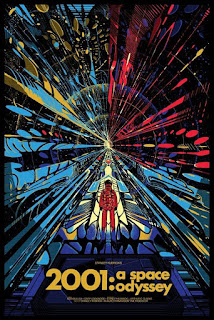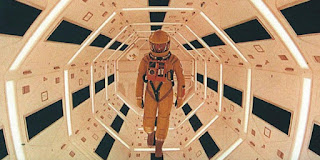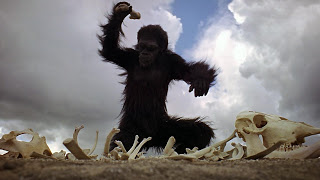 |
| (fig.1) Poster art |
Directed by Stanley Kubrick, ‘2001: A Space Odyssey’ is a
1968 film that is known as one of the most influential films in the sci-fi
genre. The film itself takes a look into the optimistic future beyond the 70s showing
strange computers, ships and space stations that would hopefully usher humanity
into a new age. Assets for the film were designed in accordance with NASA
making the possible future more believable. Filled with innovative technology,
the film itself has gone on to inspire many other sci-fi films alongside parodies
from shows such as ‘The Simpsons’, ‘Family Guy’ and ‘Futurama’. Kubrick makes
excellent use of various aspects including music, pace and the rule of thirds
to create a captivating series of images.
The film is rather odd as it opens with a black screen and an
epic orchestral score. Shortly after, we see the development of man-kind. Following
shots are seen hinting at man’s increased capacity for violence after learning
about weapons. Suddenly, the camera skips forward into the future and man has
managed to reach space setting up colonies away from Earth. Discovery of a
monolith on the moon (and intelligent life) leads to a five man team being sent
to Jupiter which ultimately ends with four of the crew dead and one other’s
fate uncertain.
Kubrick has been very deliberate with the choices he has
made in his film including the slow pace leading to a total viewing time of
just less than two and a half hours. As Roger Ebert has stated “Some of
Kubrick's effects have been criticized as tedious. Perhaps they are” (Ebert,
1968), every action, scene and moment takes a considerable amount of time to be
completed. All of it seems slow, methodical and cold. While one can debate that
this is a weakness in the film Kubrick has specifically chosen this to enact a
different tone. The slow calm nature of David Bowman, the protagonist, is a
clear example of this. Showing little to no fear this character reacts in a
cool manor. This can be said for all of the human characters, “Kubrick's actors
seem to sense this; they are lifelike but without emotion, like figures in a
wax museum” (Ebert, 1968). Not only do the cast seem emotionless but there is a
large lack of lines making them seem more detached, forcing the viewers to concentrate
on the imagery instead.
Further emphasise on the distant nature of man is suggested
by the use of uninviting camera angles. This can be evidenced in Fig. 1 as we
see the protagonist in the mid-ground. Kubrick has chosen to place him there
instead of closer up making it appear that the audience is peering from
outside, isolated from the character. The use of clever shots is used
throughout the film as Kubrick strategically places them to enhance the visual
aspect of ‘2001: A Space Odyssey’.
 |
| (fig.2) |
Kubrick uses The Rule of Thirds to great effect when
composing his shots using it to draw the viewer’s attention to certain aspects
of the screen. This is assisted by the
use of one point shots with a large amount of symmetry being favored by
Kubrick. Looking at Fig. 2 we can see that the one point shot draws all
attention towards the figure. The symmetrical nature of the chamber creates a
single point of focus as the lines all merge towards the middle of the screen.
 |
| (fig.3) |
Not only does the film achieve an amazing picture but the
sound design and score alone are capable of setting a grand atmosphere. As
Chris Jones states, “the grandeur of the planetary alignment which heralds the
''Main Title''; but to hear it alone still stirs emotion” (Jones, 2002). The
timing between the sound and footage is astounding as the music jolts to a
sudden stop at the height of tension or slowly build up to create an epic
moment. At the same time the lack of sound proved just as powerful as the audience
is strained by the cold silence with the distressful actions no longer masked
by a musical score. Some notable sound designs include the use of silent space
a first for its time and the heavy breathing of the crew. The obnoxious
inhaling and exhaling puts emphasis on man’s position in space and thus his vulnerability
without his technology.
Unexpectedly one of the most iconic characters, the computer
HAL 9000, which guides the crew through space, raised many questions through its
interaction with humans. Described as the sixth member of the crew by the conscious
men, it is only more chilling when he is dispatched by one of those he was charged
with protecting. Following the reoccurring theme of slow pace Bowman removes HAL’s
vital components one by one rendering the “sixth crew member” into the equivalent
of an electronic vegetable. To an extent Bowman has become more cold and
calculated than HAL itself doing all that it will take to survive. This leaves
HAL as “the film’s most unexpectedly sympathetic character” (Kermode, 2014) as
it slowly recalls its earliest memories before winding down to a halt.
This brings on the next point to Kubrick’s film. It is
apparent the Kubrick has chosen to leave the ending open to viewers to decipher
alongside the large amount of symbolism as little is explained. One interpretation
of the film is that man-kind has only been able to advance through the use of
tools witnessed within the first scenes; additionally man-kind has not been
able to advance without the need to destroy. Another is that man-kind has been
allowed to advance beyond their physical selves.
 |
| (fig.4) early man discovering how to utilise a weapon |
Ultimately ‘2001: A Space Odyssey’ is a breath-taking film
with powerful imagery that leaves the answers in the hands of the audience,
free to interpret the story how they like. One rather alarming insight to be
taken from this film is that man had learnt how to kill before he had learnt to
make fire.
Biblography
Mark Kermode (2014)
2001: A Space Odyssey review – Stanley Kubrick’s sci-fi epic back on the big screen
https://www.theguardian.com/film/2014/nov/30/2001-a-space-odyssey-kubrick-sci-fi-epic-back-big-screen
Chris Jones (2002)
Original Soundtrack 2001: A Space Odyssey Review
http://www.bbc.co.uk/music/reviews/dnvr/
Roger Ebert (1968)
2001: A SPACE ODYSSEY
http://www.rogerebert.com/reviews/2001-a-space-odyssey-1968
Illustration list
fig.1 https://pbs.twimg.com/media/Bx_Lcw9CcAAThrs.jpg
fig.2 http://bloggingmoviesrus.blogspot.co.uk/2015/03/2001-spacey-analysis.html
fig.3 https://consumedbyfilm.files.wordpress.com/2014/02/2001-a-space-odyssey-bowman.png
fig.4 https://blogger.googleusercontent.com/img/b/R29vZ2xl/AVvXsEj1Fec1EaSog6Flh4hxCX8YzIfYiLFjxt-N7DCPDnUxJtq_23qJ_a8Pzr17prFQKINMIFgSeLHhfVrb9LCf4FCz3tRjwcR61C8GF2crCy-JzUcfiwavXwTHQcG-fOcsTn_BUIm5OLye19Cw/s320/2001+a+space+odyssey2.jpg

























































